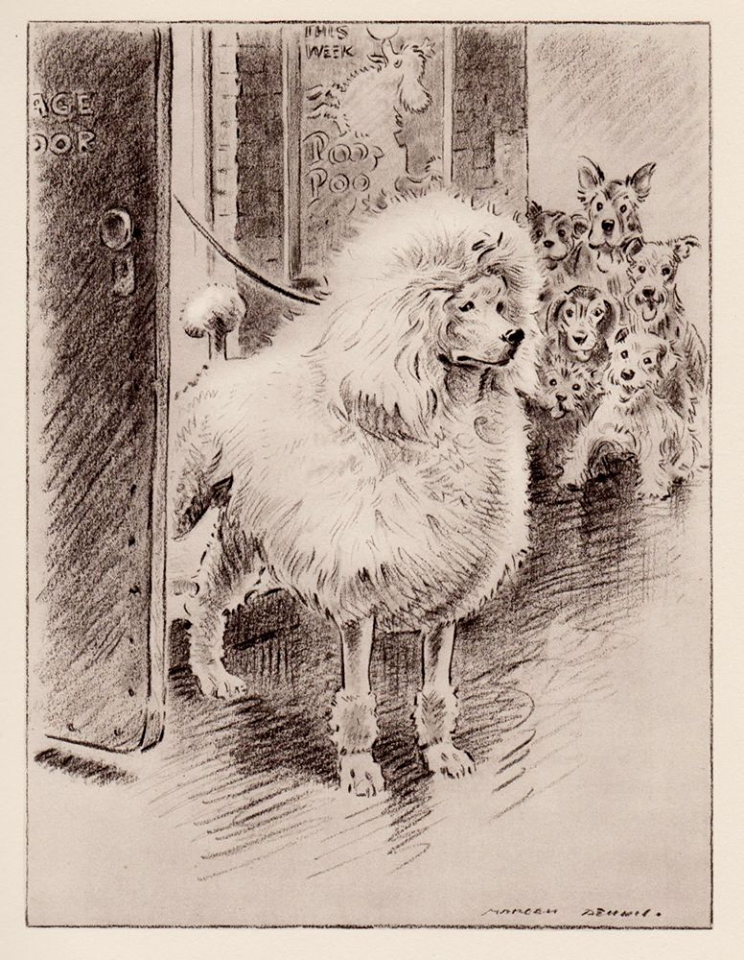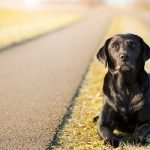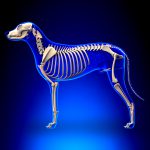
#1 Breeder Spotlight
Last month, while on the airplane to UC Davis Veterinary Genetics Laboratory, I conceived an idea of something I thought would be of value to our breeder communities. Namely, to interview titans of our breeds. We could gain historical perspectives, considerations from decades of experience, and mentoring through text (or live interviews). We all breed with a goal, but time gives perspective; there are so many breeders with legacies to pass on. So what can those who have tread through and helped stamp our histories offer us?
The following is our VERY FIRST Breeder Spotlight. We are honored to share this very first interview with Mary Jane Weir. Mary Jane Weir one of three original founders in 1956 of the Poodle Club of Canada, which is also the year of the beginning of her breeding program. She has bred for decades, and has been an inspiration to many of us.
What first sparked your passion for purebred dogs? When did you start breeding?
I’m a third-generation breeder of Purebred dogs: my great, great aunt bred English Toy Terriers before the Canadian Kennel Club was founded (at least by family recollection; no documents). My grandfather bred Standardbred horses. My mother and I bred purebred dogs. I was raised with Great Danes. I can remember a long wooden bench running the length of the house in the basement filled with Great Danes. Then my father built six Great Dane dog beds in one room upstairs, and in 1950 I came home from school and my mother took me into the room and in one bed was a Miniature Poodle puppy – tiny! That was Ch Tyldesley Capri, CD – our first Poodle we owned, although mother had been showing them for two years. She was one of the very few who held a handler’s license from the CKC before the War.
I was a working partner by the age of 8 in the kennel. Mother bred Miniatures, and the Toys. By 1960, her Mar Con Tata of Tyldesley was Eastern Canada top Winner. However, I wanted to breed Standards, and in 1955 I imported my first Standard. He was, as far as I know, the first silver Standard in Canada, Branwen Eslar Toby CD. By 1960, I had seen an apricot from England that I liked, and started that line.
Who was your mentor(s)?
I had three mentors: my mother Susie Mae Weir, Casey Gardiner of the School of Canine Science , and Shirley Walne of Vulcan Kennels. My mother gave me a sound basis in structure, using the illustrated Great Dane standard, which was one of the best guides. By the late 1950’s, we were involved with Casey Gardiner, trying to transfer the Holstein measuring system to the dogs. I was intimately involved in the whole School of Canine science effort from the beginning till the end. My first measuring clinic was in 1957, I think, but I do have records from a clinic in 62. I worked with Casey until her death in ’94. I only had two weeks with Shirley, but I whelped my first bitch with her, and she challenged my belief in inbreeding. It remained in the back of my mind until Kathryn Foran discussed it online in the 2000’s.
We all grow and change as we learn more as breeders. When you first began your program,
what was your goal?
To produce a red standard poodle equal in structure to the blacks. I tried 3 different times to get there, but each time, health problems (mainly hips) ended the line. The one dog that I use as “measurement illustration” had almost perfect structure and grade 3 hips. (It caused Casey, who was of the opinion that poor structure caused most HD, to change her mind!) Incidentally, my HD dogs did not show it until in their teens.
What might you say is your focus for your breeding program now? How has your goal changed,
and if it has, why has it changed?
I’ve given up on reds; others are breeding them and some have very good structure. For the last twenty years, I’ve been breeding for health, which means diversity. I now have 3 generations of minus IRs, and am approaching all puppies of above .30 OIs. And – getting good dogs. Next generation, I think I can go back to trying for my structure again. I’m breeding an all-round dog, good for performance and show, although performance is winning out just now. I have one dog out training for Masters in field, although the expense means that I’m unlikely to do it again.(One third of my income over two years is pretty steep!)
Those of us who have bred awhile, know it can be a rocky road full of challenges. Has there been a time in breeding you considered quitting?
Never. I have started over again four times. And from 1985 until 2002, I bred Ibizan Hounds and did very well with them. Most judges know me for those rather than Poodles. I really had Dual purpose hounds, with Top Ten lure coursing dogs for most of the time. I think I enjoyed lure coursing the most of any sport. But my first love has always been Standard Poodles. I think the fact that I’ve never married has had an impact not quitting; I didn’t have other strands pulling me away.
What was one of your high points as a breeder?
In 1991, I took one of my Ibizans to Top Lure Coursing Dog in Canada AND in the same year, one of the Poodles I sold made it to # 2 Obedience Dog in Canada. I don’t think anyone has bettered that combination.
In the years to come, when someone is writing the history of your breed, how would you like to be remembered?
The editor of dogs in Canada called me “one of the ten best minds in dogdom”. I have put my effort into two areas: the School of Canine Science and measuring, and into diversity breeding.
The measuring system (79 measurements of bone length and angle) put Canadian breeding on a scientific basis for structure. When it was at its height, Canadian dogs did very well in the international show ring. I remember one US exhibitor who said: “We could come up and get a championship in a weekend; Now we don’t even place!” Moreover, the measuring system trained breeders to look at dogs past the optical illusions.( Which is it? – long back or short legs?) There are many other illusions which take breeders in the wrong direction. Casey died in 1994. I would like to get the measuring system going again and hand it over to a successor.
Breeding for diversity – well, I don’t have to tell this audience how important it is. I started to look for an outcross in 1998. (I have turned up an immune problem in my latest generation of silver dogs.) I took my retirement year in 1998 and traveled to Europe, attending the World show at Helsinki, where I saw dogs from all over, and then I traveled all over England. Much of my knowledge of modern dogs comes from that trip. (Two dogs which I saw were The Russian silver (Zvjjozdny Malchik Dom Totem) and and Australian silver (Neiger Silver Fox for Vulcan imported to England.) I started pedigree hunting, using the Poodle Health database and the poodle database which allowed people to enter. I would take a dog in the 50’s, which I liked, and trace down the families; I very rapidly came to understand that the lines were numerous in numbers, but very restricted in diversity. Too many of the interesting lines had died out, mainly because people were neutering everything. I became friends with Natalie, and we both started searching. My criteria originally was 3 generations without a major immune problem, but that was unworkable. I settled for 1/4 of the pedigree immune-compromised, and we started looking at dogs. By 2005, we had imported a number of litters and had picked up individual dogs. I recommended a breeding of the last Leatherstocking black with a diverse dam, and all my dogs have come down from that. It was the 5th time I had started my lines all over again. What was interesting about the search was that it wasn’t just Natalie and me; there were about 10 doing similar searches. I would tell them about the dogs of the 50’s, and they would take one and work on it. It became international, with people in various countries joining in. I remained a “mover and shaker” until the publication of Dr Pedersen’s original study using Standard Poodles; then I stepped back.
You are someone who has bred almost the longest of any breeder I’ve known. How can you say the dog show world has changed, in particular the dogs themselves? How have other perspectives changed?
Dog shows have changed. In the 40’s and 50’s, they were benched. You had to be there by 9 AM and stay until 6 PM. That had consequences: people got to know other breeds, and general structure. What else was there to do? There were not as many handlers, and they did not have strings of dogs. The dogs themselves were not as refined; for example, a modern Poodle would be considered “Bitchy” then. The heyday for Standards was late 50’s and early 60’s in my opinion; the structure was outstanding , temperaments very good and they had hair. (I have measurements to prove my position.)
For an interesting historical note, how did people groom poodles when you first began breeding? How long would a show groom take?
My first Poodle, a silver, took 2 days to dry. I have never seen a coat as thick. I used to ask Sue Fraser if I could use her Poodle Studio, and there, with two dryers working, it took 4 hours. It was wire with an impossible undercoat. On the whole, because of three things, it took much longer: the coats were thicker, the trims were longer (English saddle), and the dryers less effective. The coats were not scissored as much, and the whole look was heavier and lower. Some also did not groom to our standard today, though the judges were not likely to reward them. I do believe that the handlers have had an effect, opting for easier coats to groom.
We, obviously, are a company that empowers breeders to be conservators of their breed’s long term diversity and viability. How do you use this in your breeding program?
It is not for the faint of heart. Because I have been diversity breeding since 1998, I am far ahead of most. My dogs are mainly what I want with respect to structure and health. Even with my silvers before 1998, I had never had either major disease (AD and SA). In my apricots, I had one dog, both of whose parents I bought, who was immune-compromised: she had AD, SA and died of a third immune disease. So I don’t have the sorting out to do. I have, since 2015, bred primarily from the BetterBred figures. In three generations, I have moved rapidly from low IR to a OI above .30 in my litters. My lowest IR was -.33; my highest OI is .33. Next generation, I shall go back to looking at structure and temperament; specifically fronts. (Here the measuring has an advantage: rather than looking for a “better front”, I know that I have to increase my layback 10 degrees, and increase my bone lengths to 9”, and these are connected.)
Since using BetterBred, have you had any exciting keepers you would like to brag about?
Tyldesley Soundscape. She was measured at the Montreal Conference last fall. She has a “good front” and is close to perfect on other measurements. I also have a male apricot who is a 10 (unrelated) Breeding, who is very balanced. They are my next breeding.
Do you have plans you’d like to share about your breeding program for the future?
I have seen in the last two years, 3 puppies which are “filling my eye”. They are a blue male from Alchemy, a black female whose name is short but I can’t remember it, and another from Anutta. I would be pleased to have any of them. We are coming up to a time when I will go out for a generation. (I run a “closed” breeding program, in which I breed within the kennel for several generations, then go out for one.)
And finally, do you have words of wisdom to impart on those who have not been in the breed for
long? Something you might have liked to have heard, or maybe should have heard?
1.Follow your own drummer. There are many pressures to conform to the latest fad. Don’t give in.
2. Keep learning. You will not have a good knowledge of the things you are supposed to know for about 20 years, but there is always something new to learn. I am still learning at my age.
WOW! Our most sincere thank you goes to Mary Jane for her taking the time to thoughtfully answer these questions. I hope to learn more from her in the future. Her, and those like her, hold memories and knowledge that is priceless for our breeds.
Would you like to suggest someone for our next Breeder Spotlight or be considered for it? Email theteam@betterbred.com to make your suggestion.
 Previous Post
Previous Post Next Post
Next Post


